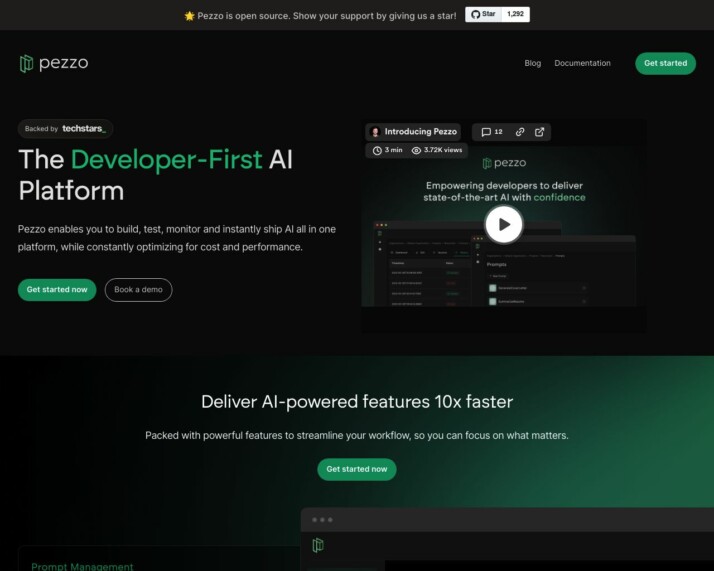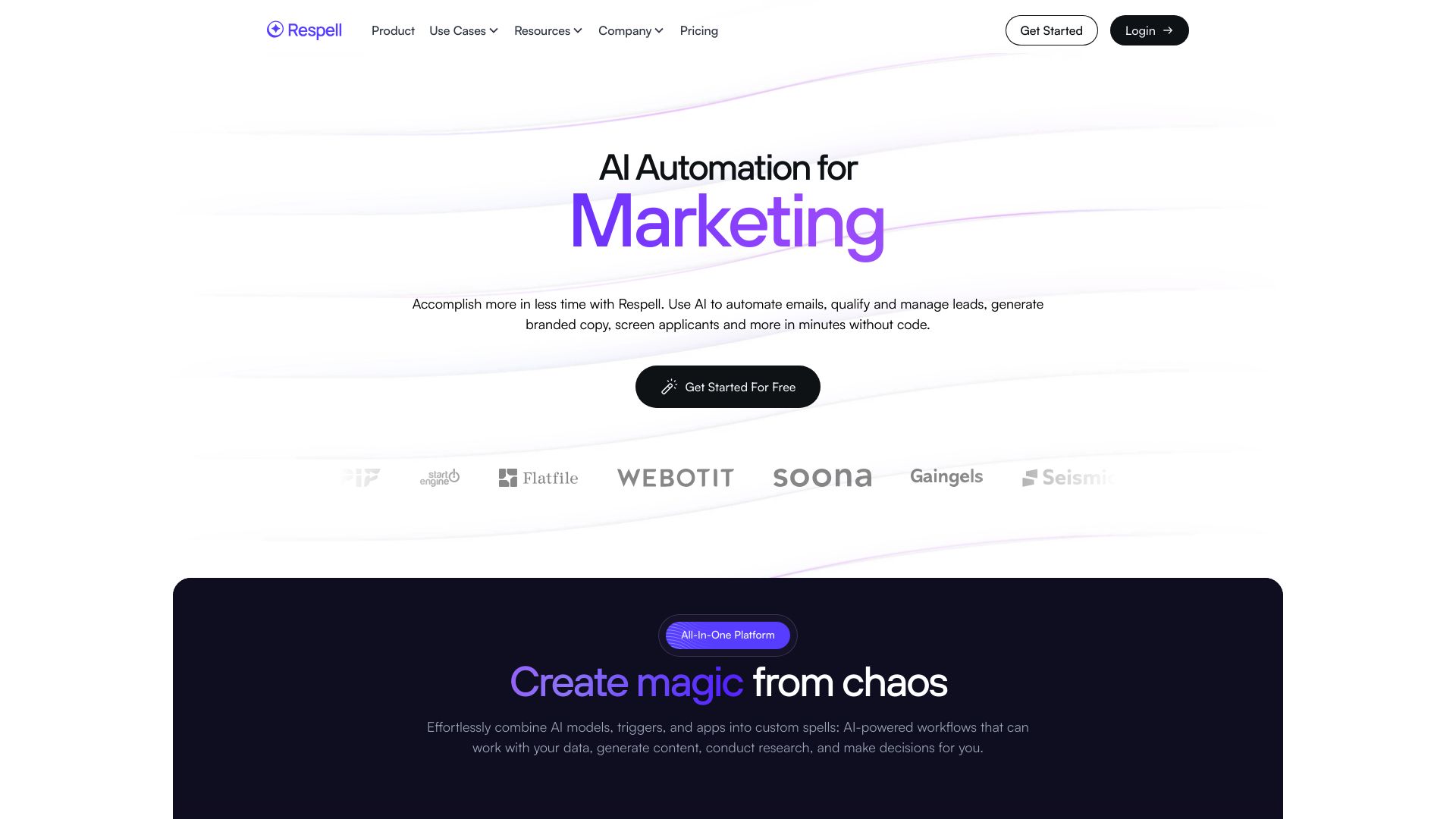Pezzo vs. Respell: Comparing AI Development Platforms
AI development platforms are transforming how businesses leverage artificial intelligence, with solutions catering to diverse needs and technical expertise. This comparison examines Pezzo, an open-source toolkit for streamlined AI operations, and Respell, a no-code platform for creating AI workflows. We’ll explore their unique approaches, strengths, and limitations, while highlighting how SmythOS addresses gaps in both offerings. By evaluating key features, integration capabilities, and target users, we aim to provide a comprehensive overview to help developers, business leaders, and AI enthusiasts make informed decisions about the most suitable AI development platform for their specific requirements.
Pezzo Overview
Pezzo streamlines AI development with an open-source toolkit designed for efficiency and collaboration. The platform excels in prompt management, allowing developers to easily design, version, and publish AI prompts. This capability accelerates AI solution delivery, crucial for teams juggling multiple projects.
Pezzo streamlines AI development with an open-source toolkit designed for efficiency and collaboration. The platform excels in prompt management, allowing developers to easily design, version, and publish AI prompts.
Pezzo’s strength lies in its comprehensive troubleshooting tools. The platform offers detailed execution history, time-travel debugging, and test suites, empowering developers to deploy AI models with confidence. These features significantly reduce debugging time and provide teams with precise insights into AI operations.


Pezzo’s strength lies in its comprehensive troubleshooting tools… empowering developers to deploy AI models with confidence.
The platform also focuses on optimizing AI costs. Pezzo’s tools help users maximize efficiency in AI operations, potentially cutting expenses by up to 50%. This cost-saving feature proves particularly valuable for businesses scaling their AI initiatives.
While Pezzo shines in prompt management and debugging, it lacks certain advanced features. The platform doesn’t offer a visual builder or no-code editor, which may limit accessibility for non-technical users. Additionally, Pezzo doesn’t provide specific tools for AI agent creation or management, focusing instead on the underlying prompts and operations.
Pezzo’s collaborative features stand out, fostering transparency and teamwork in AI development. The platform’s emphasis on observability allows teams to understand exactly what happens during AI operations, facilitating effective troubleshooting and knowledge sharing. This collaborative approach positions Pezzo as a valuable tool for development teams looking to enhance their AI workflows and productivity.
Respell Overview
Respell empowers users to create AI workflows, automations, and agents without coding experience. The platform’s no-code interface simplifies complex AI-driven tasks, making advanced technology accessible to a wider audience.


At the heart of Respell’s offering is Elle, an AI assistant that guides users through the platform’s features. Elle not only facilitates natural language interactions but also suggests agents and automations to streamline work processes. The Explore Page provides pre-built spell templates for various use cases, while the Spell Studio offers a drag-and-drop interface for customizing AI workflows.
Respell empowers users to create AI workflows, automations, and agents without coding experience. The platform’s no-code interface simplifies complex AI-driven tasks, making advanced technology accessible to a wider audience.
Respell’s integration capabilities stand out, with native support for popular platforms like Airtable, Confluence, and Salesforce. The Zapier integration expands this further, connecting Respell to over 6,000 apps. These integrations, combined with the ability to upload and reference custom data sources, allow for powerful, context-aware AI solutions.
While Respell excels in user-friendliness and integration options, it lacks some advanced features found in other platforms. The absence of multimodal capabilities, autonomous agents, and advanced problem-solving tools may limit its applicability for complex AI projects. Additionally, the platform doesn’t offer hosted vector databases or specialized data crawlers, which could be crucial for certain use cases.
Respell’s vision centers on democratizing AI use, aiming to enhance productivity across various domains. By providing a robust, no-code environment for creating AI workflows, the platform positions itself as a solution for businesses looking to harness AI’s potential without extensive technical expertise. However, users requiring more specialized or advanced AI functionalities may need to look elsewhere or combine Respell with other tools to meet their needs.
Feature Comparison
Pezzo and Respell offer distinct approaches to AI development, each with its own strengths and limitations. Pezzo excels in prompt management and debugging capabilities, providing developers with powerful tools to streamline AI operations. Its detailed execution history and time-travel debugging features give teams precise insights into AI processes, significantly reducing troubleshooting time. Pezzo also emphasizes cost optimization, potentially cutting AI operation expenses by up to 50%.
Respell, on the other hand, focuses on accessibility and ease of use with its no-code interface. The platform’s drag-and-drop Spell Studio allows users without coding experience to create complex AI workflows. Respell’s Elle AI assistant further simplifies the process by guiding users and suggesting automations. While Respell offers extensive integration options, including native support for popular platforms and a Zapier connection to over 6,000 apps, it lacks some of the advanced debugging and cost optimization features found in Pezzo.
Both platforms have notable gaps in their feature sets. Neither Pezzo nor Respell offers multimodal capabilities, autonomous agents, or advanced problem-solving tools. They also lack hosted vector databases and specialized data crawlers, which could limit their applicability for certain complex AI projects. SmythOS addresses these limitations by providing a comprehensive suite of features including multimodal support, autonomous agents, and advanced data handling capabilities, positioning it as a more versatile solution for diverse AI development needs.
Feature Comparison Table
| Pezzo | Respell | SmythOS | |
|---|---|---|---|
| CORE FEATURES | |||
| Hosted Agents (Dev, Production) | ❌ | ✅ | ✅ |
| Visual Builder | ❌ | ✅ | ✅ |
| No-Code Options | ❌ | ✅ | ✅ |
| Memory & Context | ❌ | ✅ | ✅ |
| Autonomous Agents | ❌ | ✅ | ✅ |
| SECURITY | |||
| Constrained Alignment | ❌ | ❌ | ✅ |
| IP Control | ❌ | ❌ | ✅ |
| COMPONENTS | |||
| Huggingface AIs | ✅ | ❌ | ✅ |
| Data Lakes | ❌ | ❌ | ✅ |
| DEPLOYMENT OPTIONS (EMBODIMENTS) | |||
| Staging Domains | ✅ | ❌ | ✅ |
| Production Domains | ✅ | ❌ | ✅ |
| Deploy as Scheduled Agent | ❌ | ✅ | ✅ |
| Deploy as GPT | ✅ | ❌ | ✅ |
| DATA LAKE SUPPORT | |||
| Hosted Vector Database | ❌ | ❌ | ✅ |
| Sitemap Crawler | ❌ | ❌ | ✅ |
| YouTube Transcript Crawler | ❌ | ❌ | ✅ |
Best Alternative to Pezzo and Respell
SmythOS stands out as the superior alternative to Pezzo and Respell, offering a comprehensive AI automation platform that addresses the limitations of its competitors. We’ve designed SmythOS to provide unparalleled flexibility, power, and ease of use for businesses and developers alike.
Our visual builder simplifies the creation of complex AI workflows, allowing users to design sophisticated agents without extensive coding knowledge. Unlike Pezzo’s focus on prompt management or Respell’s no-code approach, SmythOS strikes the perfect balance between accessibility and advanced capabilities. We offer a drag-and-drop interface coupled with deep customization options, empowering users to create truly tailored AI solutions.
SmythOS excels in its feature set, offering capabilities that Pezzo and Respell lack. Our platform supports multimodal interactions, enabling agents to process and respond to various data types including text, images, and audio.
SmythOS excels in its feature set, offering capabilities that Pezzo and Respell lack. Our platform supports multimodal interactions, enabling agents to process and respond to various data types including text, images, and audio. This versatility opens up a world of possibilities for creating more dynamic and responsive AI applications. Additionally, SmythOS provides robust support for autonomous agents and multi-agent collaboration, allowing for the development of sophisticated AI systems that can work independently or in teams to solve complex problems.
We’ve also prioritized scalability and integration in SmythOS. Our platform seamlessly connects with a wide array of APIs, data sources, and AI models, including those from Hugging Face and other providers. This extensive integration ecosystem ensures that SmythOS can adapt to virtually any workflow or business process. Furthermore, our hosted vector database and advanced data handling capabilities, including support for data lakes and various file formats, set us apart from both Pezzo and Respell in terms of data management and processing power.
With SmythOS, we’ve eliminated the constraints that limit other platforms. Our users enjoy unlimited use cases, from simple chatbots to complex, multi-agent systems capable of handling enterprise-level tasks. Whether you’re a small startup or a large corporation, SmythOS provides the tools and flexibility to bring your AI vision to life efficiently and effectively. Choose SmythOS for a future-proof AI development platform that grows with your needs and pushes the boundaries of what’s possible in AI automation.
Conclusion
Pezzo and Respell offer unique approaches to AI development, each with distinct strengths. Pezzo excels in prompt management and debugging, providing developers with powerful tools to streamline AI operations and potentially reduce costs. Respell, on the other hand, focuses on accessibility with its no-code interface, allowing users to create complex AI workflows without coding experience.
However, both platforms have limitations. Neither offers multimodal capabilities, autonomous agents, or advanced problem-solving tools. They also lack hosted vector databases and specialized data crawlers, which could restrict their use in complex AI projects.
SmythOS addresses these limitations and more. Our platform provides a comprehensive suite of features including multimodal support, autonomous agents, and advanced data handling capabilities. We offer a visual builder and no-code editor, making AI development accessible to both technical and non-technical users. Our platform supports multi-agent collaboration, human-AI interaction, and deploys agents as APIs, webhooks, or chatbots.
For those seeking a versatile, powerful AI development platform, we invite you to explore SmythOS. Create a free account to experience the future of AI development, or dive into our documentation to learn more about our extensive capabilities. With SmythOS, you’re not just keeping pace with AI innovation – you’re leading it.
Last updated:
Disclaimer: The information presented in this article is for general informational purposes only and is provided as is. While we strive to keep the content up-to-date and accurate, we make no representations or warranties of any kind, express or implied, about the completeness, accuracy, reliability, suitability, or availability of the information contained in this article.
Any reliance you place on such information is strictly at your own risk. We reserve the right to make additions, deletions, or modifications to the contents of this article at any time without prior notice.
In no event will we be liable for any loss or damage including without limitation, indirect or consequential loss or damage, or any loss or damage whatsoever arising from loss of data, profits, or any other loss not specified herein arising out of, or in connection with, the use of this article.
Despite our best efforts, this article may contain oversights, errors, or omissions. If you notice any inaccuracies or have concerns about the content, please report them through our content feedback form. Your input helps us maintain the quality and reliability of our information.
